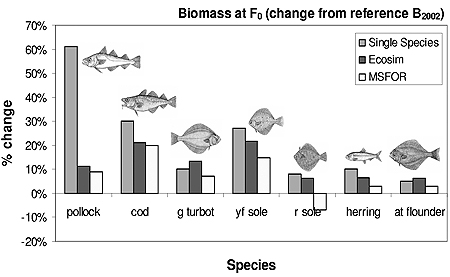Resource Ecology & Ecosystem Modeling Program
Fish Stomach Collection and Lab Analysis
Laboratory analysis was performed on 4,905 groundfish
stomachs from the eastern Bering Sea, 0 from the Gulf of Alaska, and
1,066 from the Aleutian Islands. During this quarter, 1,979 stomachs
were returned by observers. No stomachs were collected aboard research
vessels in the Bering Sea or the Gulf of Alaska, and 19,928 records were
added to the groundfish food habits database.
By Troy Buckley, Geoff Lang, and Mei-Sun Yang
Seabird-Fishery Interactions Research
Shannon Fitzgerald continues his work with the
Pollock Conservation Cooperative and Washington Sea Grant Program to
develop seabird mitigation measures for large catcher/processor vessels
in Alaska. The first part of the project is currently taking place on
board the fishing vessel Northern Jaeger, where a streamer line
apparatus and third wire crane are being tested as seabird bycatch
reduction devices. The next phase will involve a vessel with no meal
plant.
By Shannon Fitzgerald
Multispecies Modeling
The project "Modeling of multispecies groundfish
interactions in the eastern Bering Sea" has been awarded 2 years of
funding from the North Pacific Research Board. The main goals for this
project are to update Bering Sea multispecies models (multispecies
virtual population analysis (MSVPA), multispecies forecasting (MSFOR),
and multispecies statistical catch-at-age (MSM)) and to include recent
food habits and fisheries (catch-at-age) data. A new module that
includes technological interactions will be developed and tested for the
MSFOR and MSM. The new version of MSM (with the technological
interactions module) will make available the current tools used in
single-species stock assessment in a complete multispecies context and
will provide probabilistic statements on the future state of
commercially important components due to alternative management scenarios.
By Jesus Jurado-Molina
Multispecies and Ecosystem Modeling
NOAA’s 5-year plan, "Towards Understanding and
Predicting Earth’s Environment," lists as a 3- to 5-year goal
"developing the next generation of multispecies fisheries and food web
production models." To aid in this development for the Alaska region,
Kerim Aydin, Jesus Jurado-Molina, and Ivonne Ortiz helped organize a
workshop on multispecies and ecosystem modeling, hosted by the North
Pacific Fishery Management Council’s Scientific and Statistical
Committee in February 2005. At the workshop, 12 scientists from the
Alaska Fisheries Science Center (including those mentioned above),
University of Washington, and University of Alaska presented recent and
upcoming work in developing assessment-quality models of species
(predator/prey), technical (fishing gear) and management (management
strategy) interactions for input into stock assessment, and other
decision-making processes within a multispecies, multisector fishery.
Of specific interest to the workshop attendees was
the investigation of simulations in which single-species models and
multispecies models gave contrasting results. For example, Figure 1 (below)
shows the results of a simulated scenario consisting of removing all
fishing pressure within the eastern Bering Sea ecosystem, then
predicting the biomass of target species 20 years later under conditions
of average recruitment.

Figure 1. Simulated percent change of adult biomass for several target
species in the eastern Bering Sea, after removing all fishing pressure for 20 years and assuming
average recruitment over that time period, as reported by single species, multispecies (MSVPA),
and ecosystem (Ecosim) models.
This same scenario was run with three models: a
set of single species models similar to the current stock assessment
models, a MSVPA model, and an Ecosim model. Results between models were
similar for top predators such as Pacific cod and Greenland turbot.
However, results for walleye pollock, a key forage species, showed
different results when predator/prey interactions were included. Both
the multispecies and ecosystem models predicted much more modest
increases in pollock biomass than did the single-species model, as
predation increased to compensate for the increase in food supply. It is
hoped that the continued presentation of results such as these will
become a useful addition to the management process.
By Kerim Aydin
>>>continued

|

|
Quarterly sidebar
AFSC Quarterly Research Reports Jan-Mar 2005
Contents
Feature
ABL Reports
NMML Reports
RACE Reports
REFM Reports
Items
Quarterly Index
Quarterly Home
|


